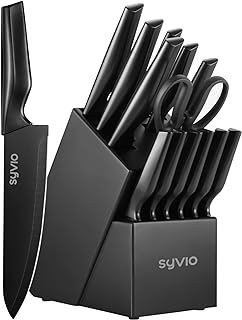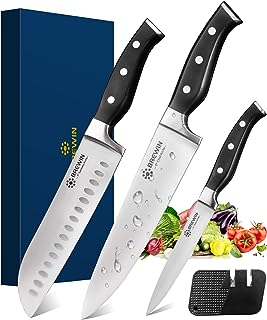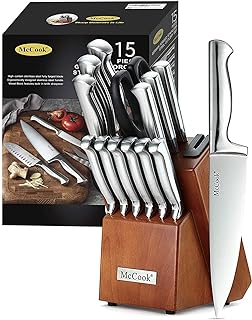5 important factors worth considering when looking for the best deboning knife
When you’re looking to buy a deboning knife, it’s important to think about more than just quality and price. There are certain things you should pay close attention to so that you can choose a knife that will be really useful in your kitchen. Understanding what makes a great deboning knife can help make cooking easier and more efficient. The material and design of the blade, the ergonomics of the handle, and the flexibility of the blade all play a big part in how well the knife works. By considering these things, you can improve your cooking skills and make deboning meat easier and more enjoyable.
See our guide to the best deboning knife.
Blade material
When looking to buy a deboning knife, the type of material the blade is made of is really important for how well it works and how long it lasts. Choosing a deboning knife with a high-carbon stainless steel blade, like X50CrMoV15 or VG-10, can make a big difference in how easy it is to debone meat. These blades are perfect because they are both hard and tough, making precise cuts without wearing out quickly. High-carbon stainless steel blades also stay sharp for a long time, which is great for handling tough deboning tasks with ease.
On the other hand, even though some people really like carbon steel blades, they can be difficult to maintain. Carbon steel blades need a lot of care to keep them from rusting, which may not be very convenient for a deboning knife. Also, carbon steel blades can change color and give off a metallic taste, which might not be appealing. In the world of deboning knives, choosing a reliable and easy-to-maintain high-carbon stainless steel blade over a high-maintenance carbon steel blade can make a big difference in your cooking experience.
Blade length
When choosing a deboning knife, the length of the blade is important for how well it will work and what you need it to do. It’s best to pick a blade that is not too long or too short. A longer blade is good for cutting bigger pieces of meat because it has more space to work with. But a shorter blade is better for detailed work that needs precision. It’s important to find the right balance between blade length and the kind of cutting you’ll be doing, so the knife performs well in the kitchen.
It’s also important to think about how comfortable the blade length is when using a deboning knife. A blade that is too long can be hard to handle for long periods, which could make you tired or more likely to make mistakes. On the other hand, a blade that is too short might make it harder to cut efficiently. So, finding a blade length that feels good in your hand is crucial for a smooth deboning experience that is both effective and pleasant. Overall, the perfect blade length for a deboning knife should combine function, control, and comfort to help improve your cooking skills.
Handle design
When choosing a deboning knife, it’s important to consider the handle design. The handle is an important part of how easy and comfortable the knife is to use. A good handle not only looks nice but also makes it easier to use the knife, especially when you need to use it for a long time doing detailed work. It should fit your hand well to reduce strain and make deboning easier and more enjoyable. It’s also important that the handle has a good grip to prevent accidents.
The material the handle is made from is also important. Strong materials like high-quality wood, plastic, or composites are best for durability and ease of care. The balance between the blade and handle is important for good control and ease of use, especially when working around bones and joints. A well-designed handle makes a deboning knife more effective in the kitchen, whether you’re a professional chef or just cooking at home.
Flexibility
When choosing a deboning knife, it’s important to focus on flexibility to improve your cooking experience. A flexible knife makes it easier to work around bones, joints, and tricky areas with accuracy. Having a blade that can bend allows you to smoothly cut through different meats, ensuring clean and efficient slices every time. Being able to adjust the flexibility of your knife for each task not only makes deboning easier but also improves the overall outcome of your dishes.
Additionally, a flexible deboning knife gives you the opportunity to try out different cuts and techniques, expanding your cooking skills. Whether you’re working on a delicate fish or a tough piece of meat, a flexible blade helps you adjust your cuts based on the texture and structure of the protein. This adaptability encourages creativity in the kitchen, allowing you to explore new ways of deboning and present your dishes beautifully. By prioritizing flexibility when choosing a deboning knife, you open yourself up to a world of precision, versatility, and endless culinary possibilities.
Balance
When you’re looking to buy a deboning knife, it’s important to consider its balance. Having a well-balanced knife can make deboning easier and more efficient. It allows for better control and precision when working around bones and joints. On the other hand, an unbalanced knife can cause hand fatigue, inaccurate cuts, and safety risks. It’s essential to find a knife that feels comfortable and balanced in your hand so you can work smoothly.
Finding the right balance in a deboning knife is crucial. The weight should be evenly distributed between the blade and handle to ensure stability and control. A knife that is too heavy on the blade end may strain your wrist, while one that is too handle-heavy can lead to lack of control and accidents. Take the time to check the balance of a deboning knife before buying it, as it can greatly affect your experience in the kitchen. A well-balanced knife is not just a tool but an extension of your hand, allowing you to cook with skill and confidence.
Conclusion
In the kitchen, there are many tools that can help chefs work with accuracy and speed. One such tool is the deboning knife. This knife is a favorite of chefs who pay close attention to detail. Its slim shape makes it easy to remove bones and connective tissue from meat or fish. Using a deboning knife is not just about getting the job done – it’s also a way for chefs to show off their skills and appreciation for good ingredients. When a chef uses a deboning knife, it’s like they are creating a work of art. It’s a reminder of the craftsmanship that goes into preparing great meals. Want more info on lucas lightweight spinner luggages, check the best lucas lightweight spinner luggages.


